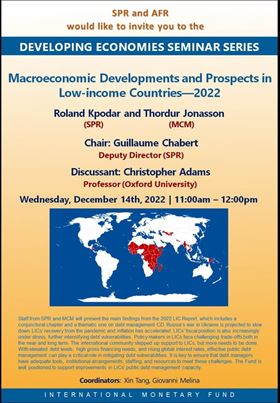
As the global economic conditions begin to normalize after years marked by COVID-19, a global food crisis, surging inflation, and high interest rates, low-income countries—which suffered the most from these shocks—are at an important juncture.
How can low-income countries overcome their current challenges? What are the potential opportunities on the horizon?
Join Kristalina Georgieva and Ajay Banga for a live discussion on what low-income countries can do to foster macroeconomic stability, promote sustainable and inclusive growth, and unlock progress toward the sustainable development goals.
Also hear from senior policy makers and experts on what role the international community can play to support these countries—from mobilizing financing and calibrating their support through strengthening debt resolution frameworks.
For more details, see AGENDA.
Read our latest report on Macroeconomic Developments and Prospects for Low-Income Countries.
















The IMF has acted with unprecedented speed and scale to support low-income countries during the pandemic. The Fund provided financial support to 53 of 69 eligible low-income countries in 2020 and in the first half of 2021, with about US$14 billion disbursed as zero percent interest rate loans from the Poverty Reduction and Growth Trust.
Most of this support was through the Fund’s emergency financing instruments—the Rapid Credit Facility (RCF) and Rapid Financing Instrument (RFI)—which provide immediate, one-time disbursements to countries facing urgent balance of payments needs. The Fund was able to respond to a record number of requests for financial assistance through a series of temporary access limit increases to the RCF and RFI, and temporary increases in the Poverty Reduction and Growth Trust (PRGT) overall access limits.

Long periods of slow economic growth can cause a jump in inequality. But a balanced set of policies can stave off that outcome.

New AI Preparedness Index Dashboard tracks 174 economies based on their digital infrastructure, human capital, labor policies, innovation, integration and regulation

The negative economic effects of conflicts are larger and more persistent, partly reflecting a sharper impact of higher-intensity conflicts in these regions.

AI will affect almost 40 percent of jobs around the world, replacing some and complementing others. We need a careful balance of policies to tap its potential

The negative impact of ‘de-risking’ strategies by major economies would be felt beyond China, while comprehensive reforms in China could generate significant positive spillovers

The economic gains from $272 billion in pandemic support for 94 countries were strongest in the poorest and more vulnerable recipients of IMF concessional financing
This paper updates the projections of the Fund’s income position for FY 2024 and FY 2025-2026 and proposes related decisions for the current and the following financial years. The paper also includes a proposed decision to keep the margin for the rate of charge unchanged until completion of the review of surcharges, but until no later than end FY 2025, at which time the Board would set the margin for the rest of FY 2025 and FY 2026. The Fund’s overall net income for FY 2024 is projected at about SDR 4.4 billion after taking into account pension-related remeasurement gain and estimated retained investment income of the Endowment Account.
On March 20, 2024, the IMF’s Executive Board reviewed the adequacy of the Fund’s precautionary balances. The review took place somewhat ahead of the standard two-year cycle, in view of the imminent attainment of the current indicative medium-term indicative target of SDR 25 billion for the first time. Precautionary balances comprise the Fund’s general and special reserves. They are a key element of the IMF’s multi-layered framework for managing financial risks. Precautionary balances provide a buffer to protect the Fund against potential losses, resulting from credit, income, and other financial risks. The review was based on the assessment framework established in 2010, which uses an indicative range for precautionary balances, linked to a forward-looking measure of total IMF non-concessional credit, to guide decisions on adjusting the medium-term target over time. While financial risks remain high, they are broadly unchanged from the last review, taking into account the further accumulation of reserves and strengthening of some risk mitigants. Against this background, Executive Directors broadly supported staff’s proposal to retain the current medium-term target of SDR 25 billion and increase the minimum floor from SDR 15 billion to SDR 20 billion. The Board also supported maintaining the biennial review cycle, with earlier reviews if warranted by developments that could materially affect the adequacy of precautionary balances.
This paper reports on the Fund’s income position for FY 2023 following the closing of the Fund’s accounts for the financial year and completion of the external audit. Overall net income of the General Department was SDR 1.7 billion, SDR 0.1 billion lower than estimated in April, mainly reflecting a decrease in the remeasurement gain reported under IAS 19 (the accounting standard for employee benefits) offset partly by higher-than-anticipated returns from the investment subaccounts compared with earlier projections.
This paper updates the projections of the Fund’s income position for FY 2023 and FY 2024 and proposes related decisions for the current and next financial year. The paper also includes a proposed decision to keep the margin for the rate of charge unchanged for financial year 2024. The Fund’s overall net income for FY 2023 is projected at about SDR 1.8 billion, slightly lower than the April 2022 estimate.
On December 12, 2022, the IMF’s Executive Board reviewed the adequacy of the Fund’s precautionary balances. The review took place on the standard two-year cycle, after an interim review in December 2021. Precautionary balances comprise the Fund’s general and special reserves. They are a key element of the IMF’s multi-layered framework for managing financial risks. Precautionary balances provide a buffer to protect the Fund against potential losses, resulting from credit, income, and other financial risks. In conducting the review, the Executive Board applied the rules-based framework agreed in 2010. Precautionary balances have risen further since the 2021 interim review and coverage metrics have strengthened. At the same, credit and other financial risks have also increased. The pace of reserve accumulation is expected to remain adequate. Against this background, Executive Directors endorsed staff’s proposal to retain the current medium-term target of SDR 25 billion and the minimum floor of SDR 15 billion. The Board also discussed the role of surcharges, which are primarily a component of the Fund’s risk management framework but also contribute to reserves accumulation.
This paper reports on the Fund’s income position for FY 2022 following the closing of the Fund’s accounts for the financial year and completion of the external audit.
Despite recent improvements, Türkiye’s low female labor force participation and high share of informal female workers stand out internationally. Closing these gender gaps would boost medium-term growth and make it more inclusive. This paper puts these gaps in an international context, explores their interlinkages with fiscal policies, and identifies policy priorities.
We provide a consistent empirical framework to estimate the net joint effect of emigration and remittances on the migrants’ countries of origin key economic variables (GDP growth and labor force participation), while addressing the endogeneity concerns using novel “shift-share” instrumental variables in the spirit of Anelli and others (2023). Understanding this joint impact is crucial for the Latin America and the Caribbean region that has seen a continuous growth in remittances over the past decades, due to steady emigration, and where remittances represent the largest capital inflows for many countries now. Focusing on the past two decades (1999-2019), this study finds that on average emigration has a negative and statistically significant impact on contemporaneous economic growth and change in labor force participation in the countries of origin across LAC, while remittances partially mitigate this adverse impact—especially on economic growth—resulting in a small negative net joint effect. There are significant differences across subregions for all estimates, with the largest negative effects observed in the Caribbean. In addition, the negative impact of emigration and remittances on the change in labor participation is small, but for the youngest cohort (15-24) is twice as large as for the overall labor force participation. The results are robust to various specifications, variables, and measurements of emigration and remittances.
Greater availability of financial access related data in recent years is increasingly enabling policymakers to better track and monitor financial access trends and developments. However, data on barriers to financial access, including costs associated with using financial services—a key factor of financial exclusion—remain scarce. To gain insight into the costs of financial access faced by the low-income segments of population, this paper presents an analysis of a novel dataset on bank pricing containing information on fees and charges associated with various banking services—collected as part of the United Nations Capital Development Fund’s (UNCDF) Making Access Possible (MAP) program—based on a market research approach for 34 low- and middle-income countries in the ASEAN, SADC, and WAEMU regions. The results of our affordability analysis reveal that the costs of maintaining a bank checking account and conducting a few basic transactions can exceed 5 percent of monthly income for consumers in more than 10 percent of the countries in the sample, mainly in the WAEMU and SADC regions. These findings underscore the considerable challenge of affordability as a significant barrier to access to financial services, especially for low-income households and SMEs. The analysis also highlights the need to collect more granular data on the affordability aspect of financial access to facilitate more effective policymaking.
We analyse the consequences of carbon price heterogeneity on households in The EU from 2010 to 2020. Accounting for both heterogeneity in carbon pricing across emission sources and the indirect effects from inter-industry linkages, we obtain two key findings. First, due to widespread carbon pricing exemptions, household burdens are lower than previously estimated. Second, lower-income groups are affected disproportionately, because they spend a smaller share of their expenditure on products that benefit from exemptions than their higher-income counterparts. Therefore, imposing uniform carbon prices both within and across countries would reduce carbon pricing regressivity on household expenditure in the EU. A global price would be most effective in this regard, as it would raise carbon prices embodied in EU imports. Further, because EU economies are open and apply higher average carbon prices than their trade partners, the domestic revenues exceed the costs embodied in EU household consumptions bundles. This increases the scope for reducing the burden of carbon pricing on lower-income households through revenue redistribution. Our results imply that the ongoing extension of carbon pricing to more sectors through the EU ETS II and the introduction of the EU’s CBAM should make carbon pricing less regressive, all else equal.
Slower passthrough of policy interest rate hikes to deposit rates relative to their loan rates has led to sharply wider bank net interest margins. Combined with resilient asset quality, wider net interest margins supported record profits for European banks in 2023. Drawing on historical data from the balance sheets and income statements of over 2,500 European banks, this paper shows that abnormally high profits are expected to fade soon as interest income will decline, once policy rates start being lowered, while higher impairment costs historically have weighed on profits with a lag. Moreover, a number of structural factors that have eroded the performance of European banks in the past two decades have largely remained unaddressed and will continue being a drag on profits and capital. Therefore, policymakers should encourage banks to preserve capital buffers and build resilience to future shocks, while exercising caution when considering taxes on profits or other measures that could divert potential sources of capital from banks.
Private consumption in the U.S. has recovered swiftly from the pandemic trough and has been running above the pre-pandemic trend even as interest rates rose sharply. This paper examines the underlying drivers for this strong growth in consumption. Using both state- and household-level data, we find that excess savings from the pandemic, large increases in household wealth (especially housing), along with solid real income gains contributed to strengthening post-pandemic consumption. Compared with pre-COVID estimates, the marginal propensity to consume out of housing wealth is substantially higher, which, together with large gains in housing prices, made the wealth effect a key driver for post-pandemic consumption growth.

A conversation on how sub-Saharan Africa can promote climate-resilient and green development. African Department director Abebe Aemro Selassie hosts the premiere episode of Africa Perspectives.

A discussion with University of Zambia students on how Zambia is making progress in its reform efforts to restore sustainability, invest in youth, combat corruption, and attract investment and the role of the IMF.

The conference provides an opportunity to discuss how South Asia can build on its development success in the aftermath of the COVID-19 pandemic and geopolitical tensions to achieve its potential.

A discussion on how the Resilience and Sustainability Trust fits wider climate objectives at the country and global level.

Jihad Azour, Director of the Middle East and Central Asia Department, presents the IMF’s latest economic outlook and growth projections for the MENA region

A presentation and discussion of the October 2022 Regional Economic Outlook for Sub-Saharan Africa.

